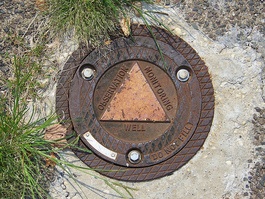The most common form of a monitoring well is completed in a single bore hole. These wells are spaced out a significant distance apart and measure subsurface water at given layers. When there is a need to monitor subsurface water at different levels in the same area, a common option is to use a nested well instead of an individual well.
What is a nested well and what is it used for?
A nested well is two or more casings within the same borehole. Each casing monitors subsurface water contaminates at a different depths. A grout seal separates each level to prevent cross-contamination. These wells are used for monitoring a number of potential contaminants including: VOCs, SVOCs, pesticides, herbicides, metals, radionuclides, inorganics, explosives, and petroleum hydrocarbons.
What are the challenges of installing a nested well during an environmental drilling project?
Nested groundwater monitoring wells are more difficult to construct than a single groundwater monitoring well. The bottom of each well casing needs complete isolation from the other well casing levels. Each groundwater monitoring wells screened intervals need a separate filter pack around it topped by bentonite seals to isolate the different casing levels from each other. The precision required in setting the seals between levels present particular challenges to drilling teams. It requires experience and constant monitoring of the entire process to insure that no cross-contamination occurs.
Any voids left in the seals can let groundwater move vertically into other layers of the borehole. This compromises the ability to get accurate readings at different levels. The more well casings in a single borehole, the more likely this vertical water and/or cross-contamination movement will occur.
How is a nested well constructed?
The construction design of nested wells differs from one installation to another, based on the number of wells involved and the size of the borehole. However, the basic construction is the same.
The drilling company drills a bore hole wide enough to accommodate all the well casings in the design. The borehole is drilled to the depth of the deepest well casing planned. After installation of each well casing, the base gets a filter pack, topped with an annular seal. The seal keeps each level separated from the ones above and below.
Once all well casings and seals are in place, the well is completed per state and federal requirements. The only difference is the nested groundwater monitoring well will have multiple sampling points in the same location.
Talon/LPE has installed thousands of groundwater monitoring wells across the southwest region and many of these have been nested wells. We provide a variety of drilling techniques and work in Texas, Oklahoma, New Mexico and Kansas. We have offices in Amarillo, Midland and San Antonio, Texas; Artesia, New Mexico; and Oklahoma City, Oklahoma. Contact Talon/LPE today for your next drilling project.

